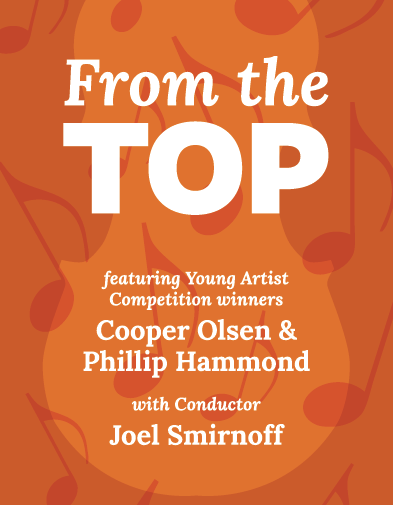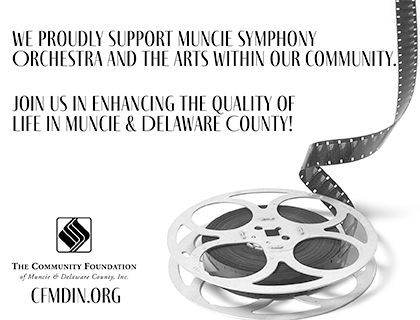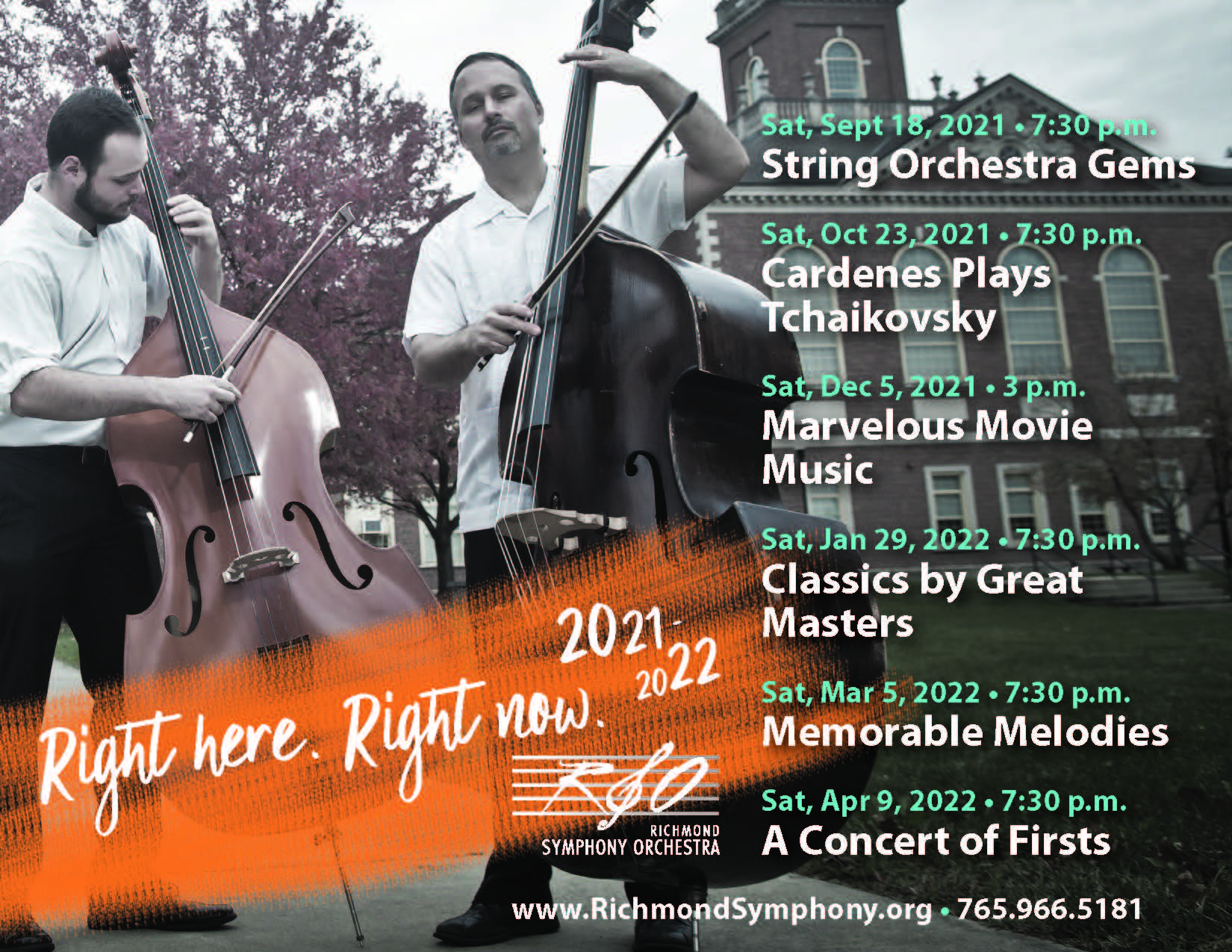
Join the MSO as two Young Artist Competition winners are taken “From the Top” to be interviewed and to impress the audience with their musical prowess. The Youth Orchestra of East Central Indiana will also join us on selections in the first half. The second half of the concert will feature Tchaikovsky’s “Symphony No. 5.”
FROM THE TOP
Joel Smirnoff, conductor
ARTIST is represented by Schmidt Artists International, Inc.
Cooper Olsen, violin
Phillip Hammond, violin
Overture to Die Meistersinger — Richard Wagner
Violin Concerto No. 2 in G Minor, Op. 63 — Sergei Prokofiev
I. Allegro moderato
Cooper Olsen, violin
Violin Concerto No. 4 in D Major, K. 218 — Wolfgang Amadeus Mozart
I. Allegro
Phillip Hammond, violin
Intermission
Symphony No. 5, Op. 64 — Pyotr Ilyich Tchaikovsky
I. Andante - Allegro con anima - Molto più tranquillo
II. Andante cantabile, con alcuna licenza
III. Valse. Allegro moderato
IV. Finale: Andante maestoso – Allegro vivace – Meno Mosso
Richard Wagner (1813-1883), Overture to Die Meistersinger
Aside from Beethoven, the composer who cast the biggest shadow during the 19th century was undeniably Wagner. A German composer who never played any musical instrument, Wagner developed distinct musical and artistic philosophies that were either loved or hated by his contemporaries. Wagner is best remembered as a composer of operas, although he preferred to call them “music dramas,” feeling that his term gave the music and the storyline equal importance. With no shortage of ego, Wagner had the Bayreuth Theater built in Germany to his own specifications, and it was dedicated to performances of his operas alone.
An average performance of Wagner’s opera Die Meistersinger (1868) takes about four and a half hours, making it one of the very longest operas. Set in the German city of Nuremberg during the Renaissance, the plot revolves around a guild of amateur poets and musicians called the Meistersinger (Master Singers). Die Meistersinger is the only comic opera from Wagner’s mature works, and it is also unusual for being set in a specific historical time. Wagner’s plots typically involved mythical tales and Norse legends. The overture to this opera, heard today, showcases the extreme contrasts that Wagner was capable of. The beginning and end of the overture feature powerful fanfares played by the full orchestra, while in between there are delicate woodwind solos and elaborate counterpoint between winds and strings.
© James Thompson, 2021
W.A. Mozart (1756-1791), Violin Concerto No. 4 in D Major, 1st movement
The Violin Concerto No. 4 in D Major is one of four violin concerti that Mozart composed in 1775 in Salzburg, Austria. He was only 19 years old at the time. It is not certain whether he composed it with the intention of performing the solo violin part himself, or whether it was for Italian violinist Gaetano Brunetti. Mozart was adept at both violin and keyboard, although in his adult years he preferred to solo on keyboard, perhaps to distinguish himself from his violinist father. The date of the premiere of this concerto is unknown. With the violin concerti that Mozart wrote in 1775, he was gradually working towards the mature treatment of the concerto form which would manifest itself in his later piano concerti. The first movement of this concerto begins with a march-like rhythm played by the full orchestra. Typical of the era, the orchestra is small, consisting of only pairs of oboes and horns in addition to strings. The solo violin part is the perfect balance of expression and virtuosity.
© James Thompson, 2020
Sergei Prokofiev (1891-1953), Violin Concerto No. 2 in G Minor, Op. 63, 1st movement
While many composers of the early 20th century were becoming increasingly experimental and Avant-garde, a few looked back to the past. One such “retro” composer was Sergei Prokofiev, a Russian who favored a style now known as Neoclassicism. Neoclassicists were inspired to write in the style of composers of the Classical Era, such as Mozart and Haydn. Rather than merely imitating those composers, however, Neoclassicists tried to imagine how Mozart and Haydn would have composed if they were alive in the 20th century. Thus, the Neoclassical style retains the lightness and clarity from Mozart’s time, but with more updated harmonic and rhythmic devices. Prokofiev’s second violin concerto was commissioned on behalf of Robert Soetans, the French violinist who premiered the concerto in Madrid on December 1, 1935. The first movement, performed today, combines the simplicity of the Neoclassical style with subtle hints of traditional Russian folk music.
© James Thompson, 2021
Pyotr Ilyich Tchaikovsky (1849-1893), Symphony No. 5, Op. 64
The second Russian composer on tonight’s program, Tchaikovsky one of a few classical composers whose music is widely recognized even by people who don’t listen to classical music. Tchaikovsky’s 1812 Overture is heard in the movie V for Vendetta (and at 4th of July celebrations), the love theme from his Romeo & Juliet Overture appears in many romantic movies, and music from the Nutcracker is a staple of holiday movies and commercials. Tchaikovsky’s Symphony No. 5 might not be as widely recognized as those pieces, but nevertheless it has become a cornerstone of the standard orchestral repertoire.
Tchaikovsky composed Symphony No. 5 during the summer of 1888. Based on letters he wrote during the symphony’s composition, it seems that he was troubled by dark thoughts and self-doubt, and these emotions present themselves particularly in the symphony’s turbulent first movement. At its premiere, the piece was not well-received by critics, and Tchaikovsky came to regard it as something of a failure.
Symphony No. 5 is a motto symphony, meaning that a melodic motif is used in every movement to provide cohesion and unity to the entire work. Tchaikovsky’s motto is first presented at the beginning of the first movement, played by the clarinets. The motto theme is somber and ominous, in a minor key. Interestingly, the motto’s rhythm and melody are very similar to a Russian Orthodox Easter hymn called “Christ Is Risen!”
After the tumultuous emotions of the first movement, the second movement relaxes into a lyrical horn solo and then gradually builds up to a huge, passionate climax played by the full orchestra. The motto theme is heard twice in this movement. The third movement features prominent waltz rhythms, with several contrasting melodies played by strings and woodwinds. A flighty scherzo interrupts the middle of the movement. Tchaikovsky sneaks the motto theme into this movement too, played by the clarinets and bassoons with rhythms slightly altered to fit into the triple meter waltz.
In the final movement, the motto theme is transformed from its original somber minor key into a triumphant major key variant, which brings the symphony to a jubilant conclusion. Some critics have speculated that the symphony could be programmatic, with the motto theme representing fate. Then, the minor key to major key progression of the entire symphony could symbolize Tchaikovsky triumphing over his own fate. If Beethoven’s famous Fifth Symphony is often described as “Fate knocking at the door,” then Tchaikovsky’s Fifth Symphony is “Fate trying get out.”
© James Thompson, 2021


















